Abstract
Our purpose was to determine whether exposure to a realistic concentration of nitrogen dioxide (NO2) could increase the bronchial sensitivity of asthmatic patients to bronchoconstrictor agents. We established dose-response curves for changes in specific airway resistance (SRaw) in response to aerosolized carbachol in 20 asthmatics after each had spent 1 h in an exposure chamber breathing on one occasion unpolluted air and on a separate occasion 0.1 ppm NO2: sequence of exposures to unpolluted air and to low levels of NO2 were randomized in a single-blind fashion. NO2 induced a slight but significant increase in initial SRaw and enhanced the bronchoconstrictor effect of carbachol in 13 subjects: curves were shifted to the left and the mean dose of carbachol producing a twofold increase in initial SRaw was decreased from 0.66 mg to 0.36 mg (P less than 0.001). In contrast, NO2 neither modified the initial SRaw nor the bronchoconstrictor effect of carbachol in seven subjects. In 4 out of the 20 subjects, exposure to a higher concentration of NO2 (0.2 ppm) yielded variable results. Potentiation of the carbachol bronchoconstrictor response by NO2 could not be related to any physical or clinical characteristics of the subjects tested. Although the mechanisms underlying the NO2 effect remain controversial, the present results demonstrate that very low levels of NO2 can adversely affect some asthmatics.
Full text
PDF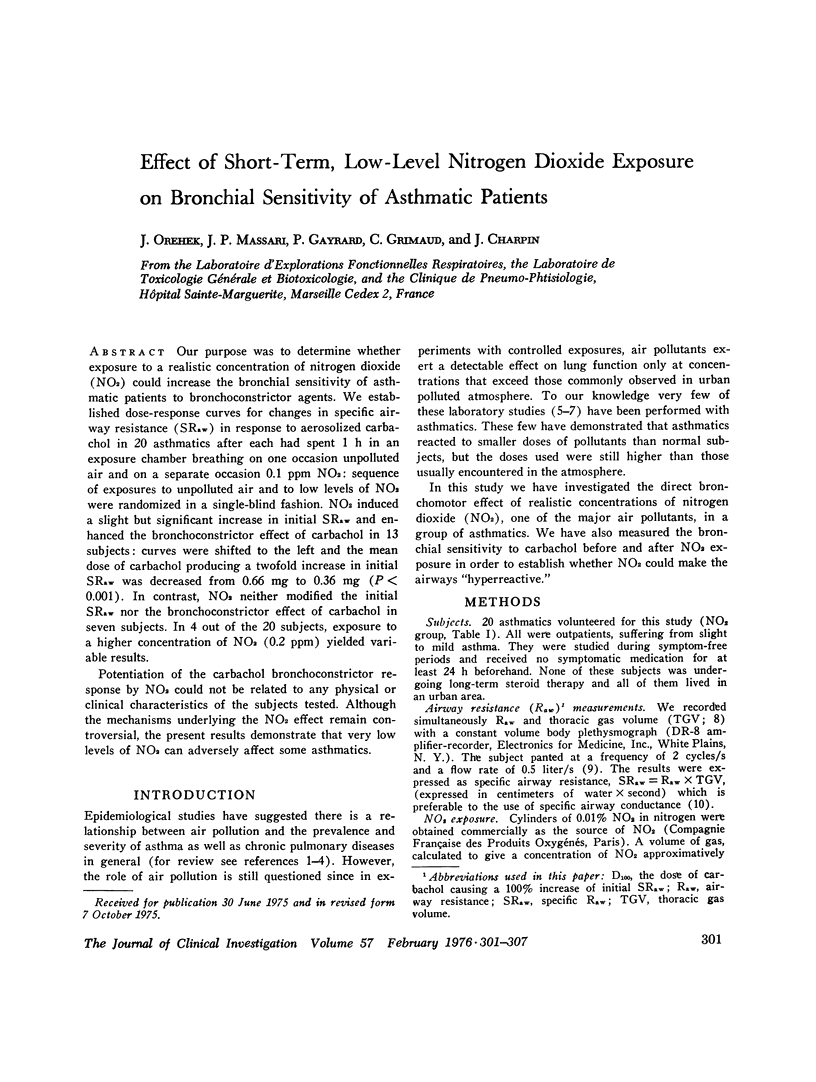
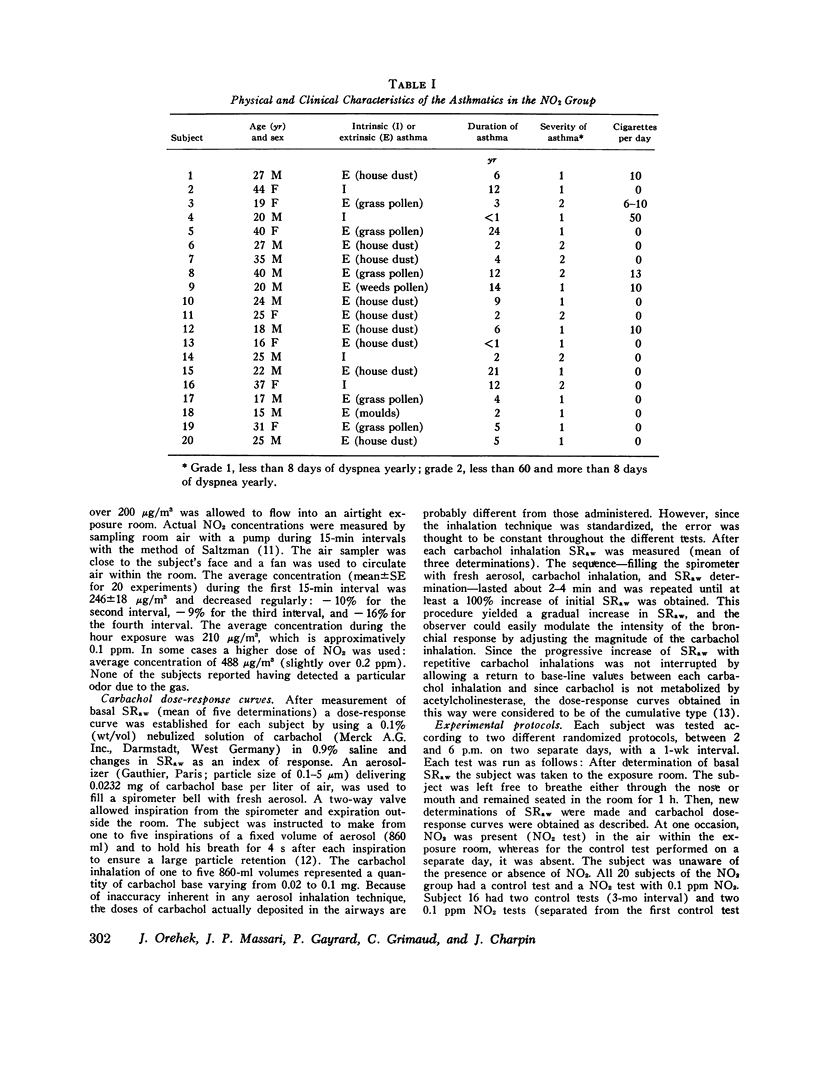
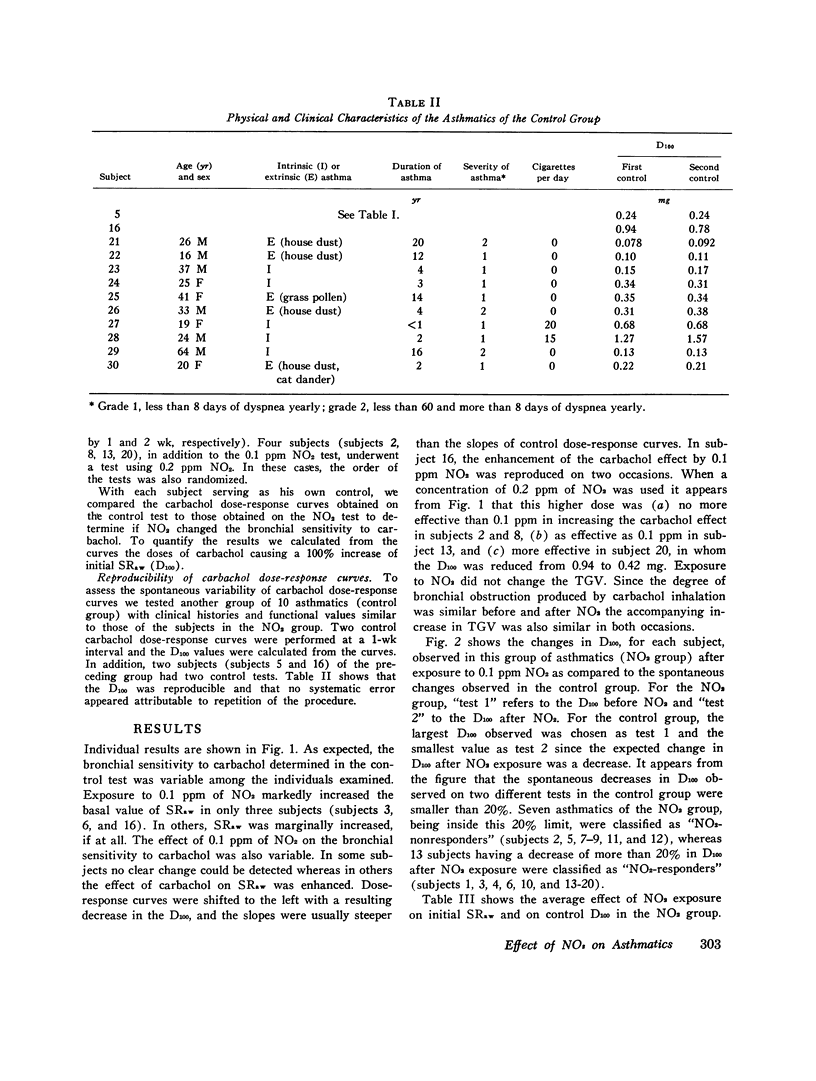
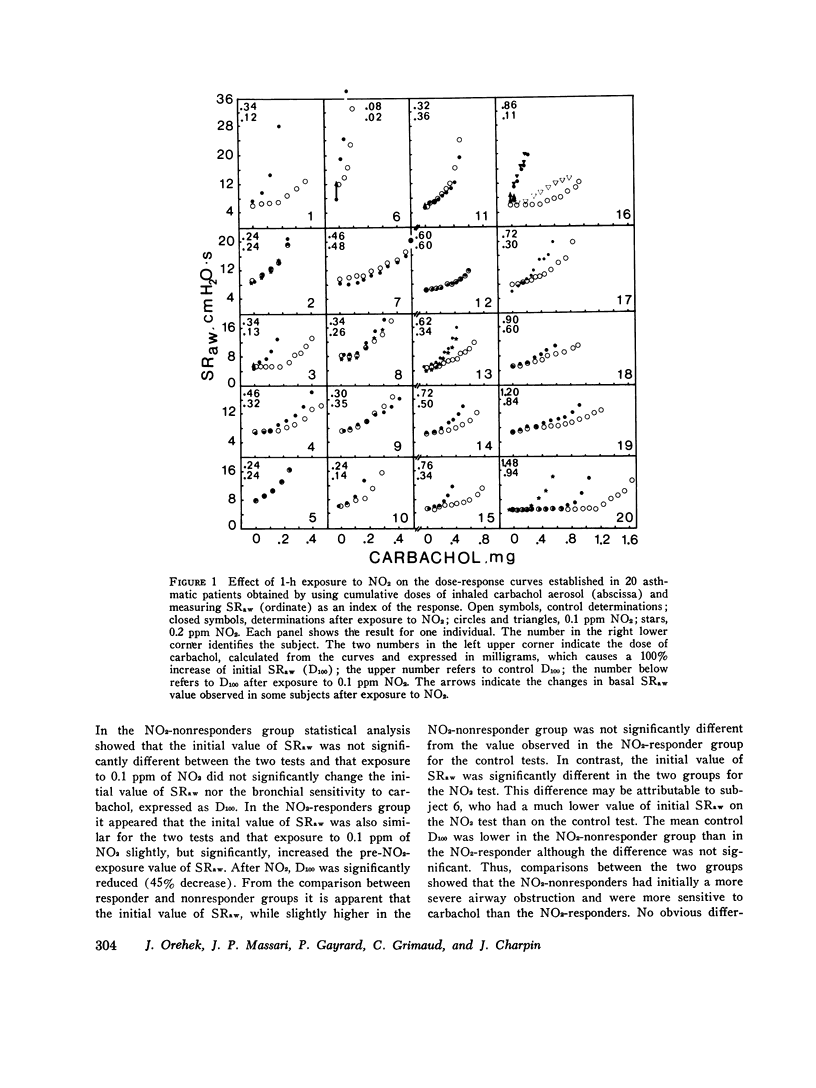
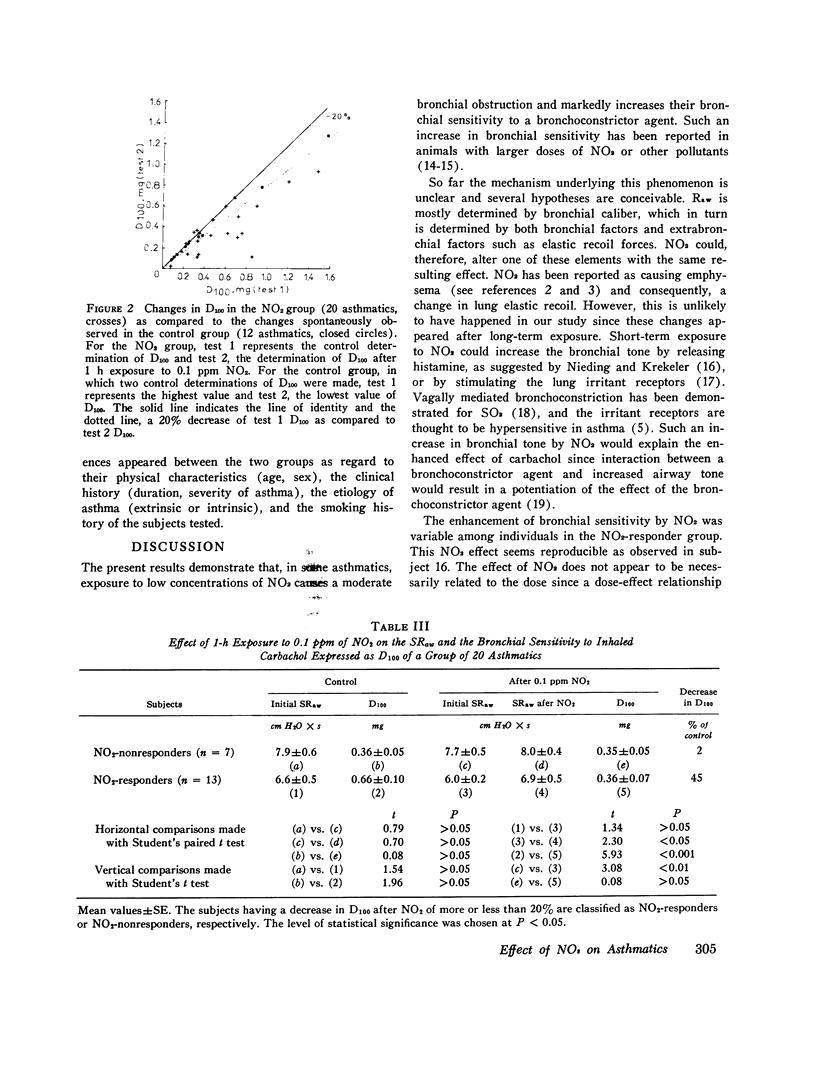
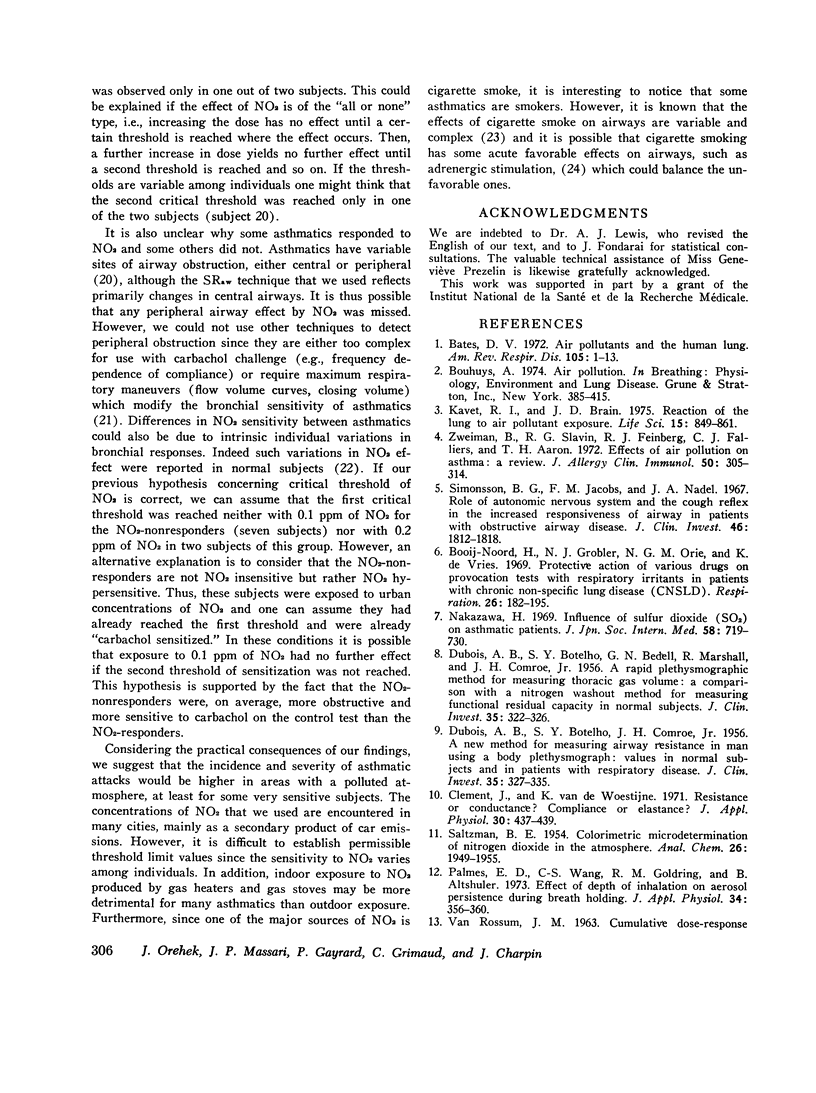
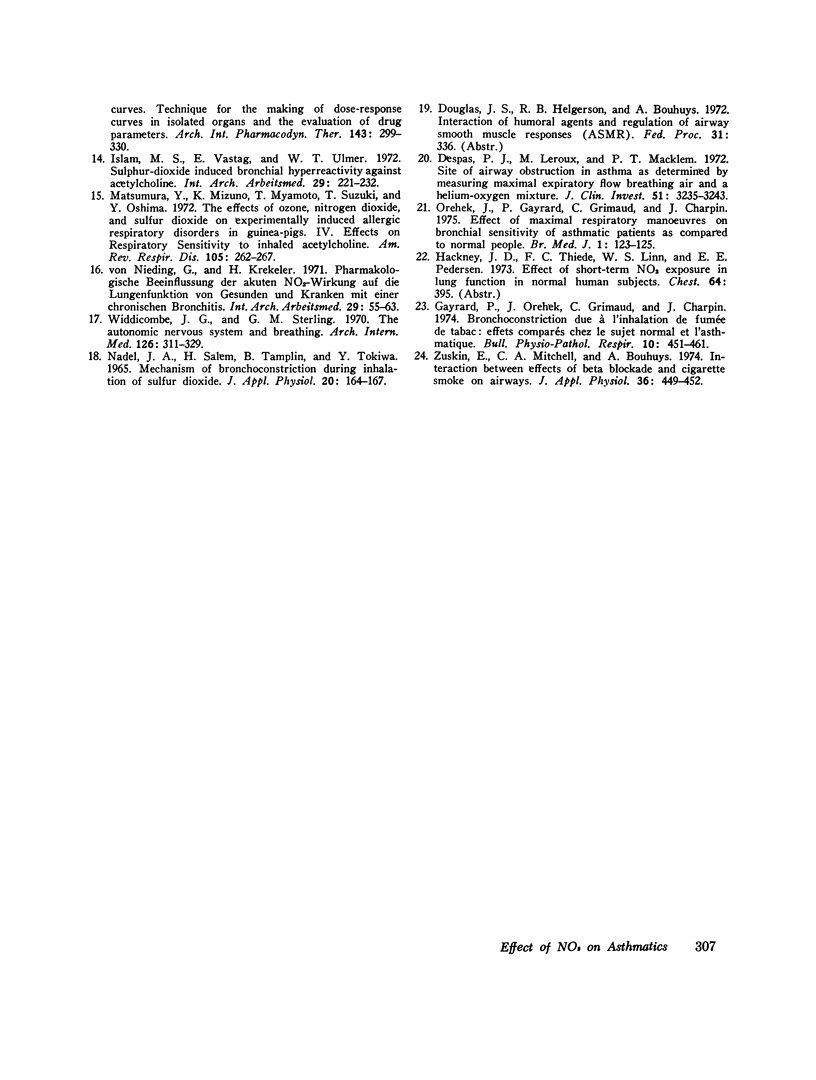
Images in this article
Selected References
These references are in PubMed. This may not be the complete list of references from this article.
- Bates D. V. Air pollutants and the human lung. The James Waring memorial lecture. Am Rev Respir Dis. 1972 Jan;105(1):1–13. doi: 10.1164/arrd.1972.105.1.1. [DOI] [PubMed] [Google Scholar]
- Booij-Noord H., Grobler N. J., Orie N. G., de Vries K. Protective action of various drugs on provocation tests with respiratory irritants in patients with chronic non-specific lung disease (CNSLD). Respiration. 1969;26(3):182–195. doi: 10.1159/000192605. [DOI] [PubMed] [Google Scholar]
- Clément J., van de Woestijne K. P. Resistance or conductance? Compliance or elastance? J Appl Physiol. 1971 Mar;30(3):437–439. doi: 10.1152/jappl.1971.30.3.437. [DOI] [PubMed] [Google Scholar]
- DUBOIS A. B., BOTELHO S. Y., BEDELL G. N., MARSHALL R., COMROE J. H., Jr A rapid plethysmographic method for measuring thoracic gas volume: a comparison with a nitrogen washout method for measuring functional residual capacity in normal subjects. J Clin Invest. 1956 Mar;35(3):322–326. doi: 10.1172/JCI103281. [DOI] [PMC free article] [PubMed] [Google Scholar]
- DUBOIS A. B., BOTELHO S. Y., COMROE J. H., Jr A new method for measuring airway resistance in man using a body plethysmograph: values in normal subjects and in patients with respiratory disease. J Clin Invest. 1956 Mar;35(3):327–335. doi: 10.1172/JCI103282. [DOI] [PMC free article] [PubMed] [Google Scholar]
- Despas P. J., Leroux M., Macklem P. T. Site of airway obstruction in asthma as determined by measuring maximal expiratory flow breathing air and a helium-oxygen mixture. J Clin Invest. 1972 Dec;51(12):3235–3243. doi: 10.1172/JCI107150. [DOI] [PMC free article] [PubMed] [Google Scholar]
- Gayrard P., Orehek J., Grimaud C., Charpin J. Bronchoconstriction due à l'inhalation de fumée de tabac: effets comparés chez le sujet normal et l'asthmatique. Bull Physiopathol Respir (Nancy) 1974 Jul-Aug;10(4):451–461. [PubMed] [Google Scholar]
- Islam M. S., Vastag E., Ulmer W. T. Sulphur-dioxide induced bronchial hyperreactivity against acetylcholine. Int Arch Arbeitsmed. 1972;29(3):221–232. doi: 10.1007/BF00539250. [DOI] [PubMed] [Google Scholar]
- Kavet R. I., Brain J. D. Reaction of the lung to air pollutant exposure. Life Sci. 1974 Sep 1;15(5):849–861. doi: 10.1016/0024-3205(74)90002-2. [DOI] [PubMed] [Google Scholar]
- Matsumura Y., Mizuno K., Miyamoto T., Suzuki T., Oshima Y. The effects of ozone, nitrogen dioxide, and sulfur dioxide on experimentally induced allergic respiratory disorder in guinea pigs. IV. Effects on respiratory sensitivity to inhaled acetylcholine. Am Rev Respir Dis. 1972 Feb;105(2):262–267. doi: 10.1164/arrd.1972.105.2.262. [DOI] [PubMed] [Google Scholar]
- NADEL J. A., SALEM H., TAMPLIN B., TOKIWA Y. MECHANISM OF BRONCHOCONSTRICTION DURING INHALATION OF SULFUR DIOXIDE. J Appl Physiol. 1965 Jan;20:164–167. doi: 10.1152/jappl.1965.20.1.164. [DOI] [PubMed] [Google Scholar]
- Nakazawa H. Influence of sulfur dioxide (SO2) on asthmatic patients. Nihon Naika Gakkai Zasshi. 1969 Aug;58(8):719–730. doi: 10.2169/naika.58.719. [DOI] [PubMed] [Google Scholar]
- Orehek J., Gayrard P., Grimaud C., Charpin J. Effect of maximal respiratory manoeuvres on bronchial sensitivity of asthmatic patients as compared to normal people. Br Med J. 1975 Jan 18;1(5950):123–125. doi: 10.1136/bmj.1.5950.123. [DOI] [PMC free article] [PubMed] [Google Scholar]
- Palmes E. D., Wang C. S., Goldring R. M., Altshuler B. Effect of depth of inhalation on aerosol persistence during breath holding. J Appl Physiol. 1973 Mar;34(3):356–360. doi: 10.1152/jappl.1973.34.3.356. [DOI] [PubMed] [Google Scholar]
- Simonsson B. G., Jacobs F. M., Nadel J. A. Role of autonomic nervous system and the cough reflex in the increased responsiveness of airways in patients with obstructive airway disease. J Clin Invest. 1967 Nov;46(11):1812–1818. doi: 10.1172/JCI105671. [DOI] [PMC free article] [PubMed] [Google Scholar]
- VAN ROSSUM J. M. Cumulative dose-response curves. II. Technique for the making of dose-response curves in isolated organs and the evaluation of drug parameters. Arch Int Pharmacodyn Ther. 1963;143:299–330. [PubMed] [Google Scholar]
- Widdicombe J. G., Sterling G. M. The autonomic nervous system and breathing. Arch Intern Med. 1970 Aug;126(2):311–329. [PubMed] [Google Scholar]
- Zuskin E., Mitchell C. A., Bouhuys A. Interaction between effects of beta blockade and cigarette smoke on airways. J Appl Physiol. 1974 Apr;36(4):449–452. doi: 10.1152/jappl.1974.36.4.449. [DOI] [PubMed] [Google Scholar]
- Zweiman B., Slavin R. G., Feinberg R. J., Falliers C. J., Aaron T. H. Effects of air pollution on asthma: a review. J Allergy Clin Immunol. 1972 Nov;50(5):305–314. doi: 10.1016/0091-6749(72)90029-2. [DOI] [PubMed] [Google Scholar]
- von Nieding G., Krekeler H. Pharmakologische Beeinflussung der akuten NO 2 -Wirkung auf die Lungenfunktion von Gesunden und Kranken mit einer chronischen Bronchitis. Int Arch Arbeitsmed. 1971;29(1):55–63. [PubMed] [Google Scholar]



